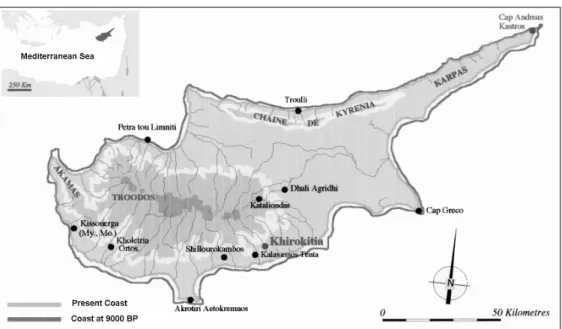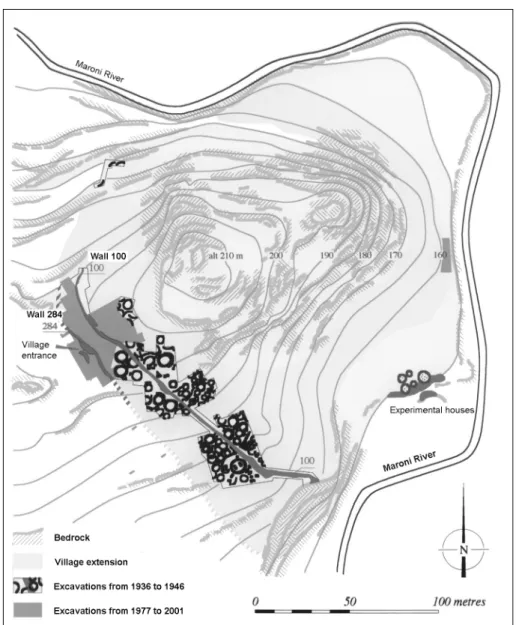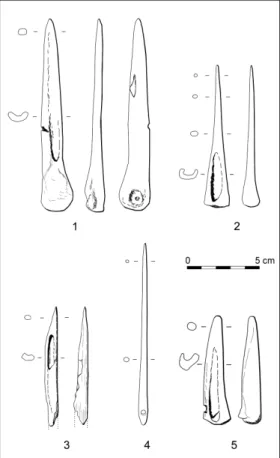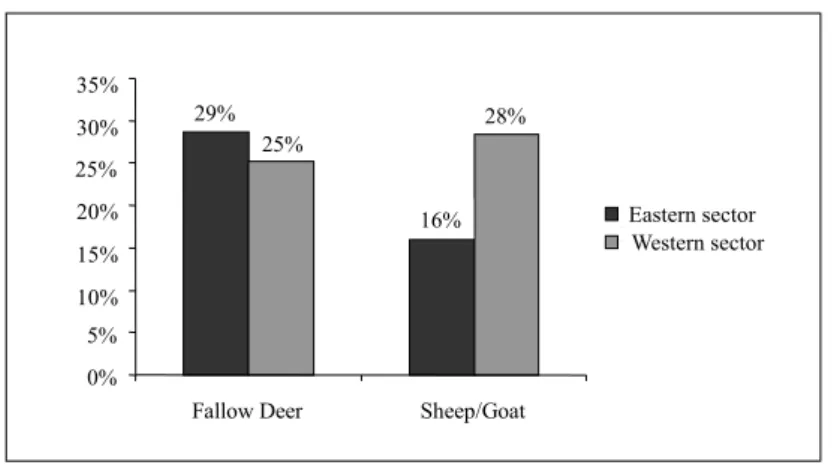HAL Id: hal-01565069
https://hal.archives-ouvertes.fr/hal-01565069
Submitted on 19 Jul 2017HAL is a multi-disciplinary open access archive for the deposit and dissemination of sci-entific research documents, whether they are pub-lished or not. The documents may come from teaching and research institutions in France or abroad, or from public or private research centers.
L’archive ouverte pluridisciplinaire HAL, est destinée au dépôt et à la diffusion de documents scientifiques de niveau recherche, publiés ou non, émanant des établissements d’enseignement et de recherche français ou étrangers, des laboratoires publics ou privés.
Khirokitia – Cyprus New evidence on the bone
reduction techniques from Khirokitia – Cyprus (7 th
millennium calBC)
Alexandra Legrand-Pineau
To cite this version:
Alexandra Legrand-Pineau. New evidence on the bone reduction techniques from Khirokitia – Cyprus New evidence on the bone reduction techniques from Khirokitia – Cyprus (7 th millennium calBC). 4th Meeting of the WBRG , Aug 2003, Tallinn, Estonia. pp.105-112. �hal-01565069�
Fig. 1. Map of the aceramic Neolithic sites in Cyprus (adapted from Gomez & Pease 1992).
New evidence on the bone reduction techniques from
Khirokitia – Cyprus (7
thmillennium calBC)
Alexandra Legrand
The excavations at the aceramic Neolithic village of Khirokitia – Cyprus – yielded a rich bone artifact assemblage dominated by pointed tools including awls and needles. To date, more than 2000 artifacts have been studied. This paper focuses on bone reduction techniques, especially the variability in the reduction sequences related to the manufacture of awls that were made from long bones such as metapodials. This study reveals that awls were mainly produced using rapid and expedient techniques. It will be demonstrated that the exact pattern of techniques could be identified throughout the site’s occupation.
Alexandra Legrand, UMR 7041, ARSCAN, “Préhistoire en Méditerranée Orientale: Chypre et Jordanie”, Maison de l’Archéologie et de l’Ethnologie René Ginouvès, 21 Allée de l’Université, 92000 Nanterre; a.legrand@free.fr
Introduction
The site of Khirokitia – 7th millennium to the first half of the 6th millennium calBC – illustrates the
latest phase of the aceramic Neolithic in Cyprus (Le Brun 2001). Located on the slope of a hill, 6 km away from the actual southern coastline, the village is protected from north to southeast by one of the meanders of the Maroni River, which flows from Mount Troodos (Fig. 1). Toward the west, where there is no natural boundary, a stone wall – structure 100 – was built to provide artificial protection (Fig. 2). This structure delimitates the eastern sector of the site, which corresponds to the first occupation. The population later expanded to the west, beyond the structure, to previously unoccupied land. The new settlement, referred to as the western sector, is also enclosed by a second wall – structure 284 – (Fig. 2) (Le Brun 2000; 1984).
Fig. 2. Plan of Khirokitia (adapted from Le Brun & Daune-Le Brun 2003).
The site has been subjected to extensive archaeological research, which has included detailed analysis of the animal and plant husbandry, building techniques, funerary practices, and craft activities. On the basis of these studies, it has been demonstrated that Khirokitia is a key site that defines the latest phase of the aceramic Neolithic on the island (Astruc 2002; Le Brun 1994; 1989; 1984; Le Brun et al. 1987). However, to date, less attention has been paid to the bone industry (Stordeur 1985; 1984). In this context, my first aim was to characterize the production and use of bone artifacts of the Cypriot Neolithic through detailed analysis of manufacture and use wear traces. In this paper, I intend to define bone technology by focusing on awls, which represent the
Fig. 3. Bone tools from Khirokitia: 1–3 awls; 4
needle; 5 edged tool (drawings by O. Daune-Le Brun and A. Legrand).
Table 1. Distribution of bone artifacts by sector. main bone tool category within the Khirokitia
assemblage. The first step is to identify the animal species selected as well as different types of bones used. The second step is to identify manufacturing techniques and their degree of variability. A comparison of the eastern and western tool assemblages from the site will permit us to evaluate Khirokitia’s stability or, at least, changes in bone techno-logy from a chronological perspective. Khirokitia’s bone industry
The total number of bone artifacts excavated in the aceramic levels comes to a total of 2053 specimens: 1017 for the eastern sector and 1036 for the western sector.
This assemblage comprises four bone artifacts categories (Table 1). The first category – classifiable tools – represents 66.88% of the assemblage. It includes awls, needles, edged tools and unfinished needles (Fig. 3). Awls and needles – comprised of unfinished needles – are the most common finds in this category. They represent 96.87% of the assemblage while edged tools represent only 3.13%.
The second category – debitage debris (1.60%) – is mainly composed of fragments resulting from the manufacture of awls and edged tools made from long bones (22 out of 33). The remaining 11 specimens are associated with the manufacture of fallow deer (Dama
The third category – other finished objects – comprises a small number of artifacts, such as combs, handles, pendants, and other specimens with unusual morphology. These represent 0.83% of the assemblage.
The fourth category consists of undetermined fragments of finished objects (30.20%). Only a few fragments remain completely unidentifiable (0.49%).
Awl production
Raw materials
The raw materials used to produce awls as well as other bone artifacts were derived from animals hunted and herded by the Khirokitia inhabitants. These animals include fallow deer, sheep, goat and pig. These species represent 95% of the identified fauna (Davis 1994; 1989; 1984). The faunal assemblage also includes a number of other taxa, cat, dog, fox, fish and bird. Of these species bird and fish bones could also be used to manufacture artifacts. Few artifacts were made from deer antler. Evidence for shed antler elements show that this raw material, consisting of antler racks collected outside the settlement, was procured differently from bones derived from slaughtered animals.
It must be stressed that the species or group of species used to produce awls could be identified for 13.85% of the specimens. Fallow deer (52 out of 95 identified species) and caprines (n=42) represent the majority of the exploited species. Only one awl came to light which had been manufactured from the spine of a dorsal fish fin (bone identified by J. Desse). Within the context of this paper, this tool will not be considered since this unique example cannot be considered representative of the awl assemblage.
The small number of represented species in the awl sample is related to the fragmentary nature of the material (89.05% of the awl assemblage is fragmented) but also to the nature of the tool blanks. As will be seen below, many tools were made from simple diaphysis fragments from long bones. These fragments have hardly any identifying characteristics (if at all) that would permit their identification to the species level.
Interesting information could be gleaned through a comparison of faunal bone excavated in the two sectors of Khirokitia. Within the identified faunal assemblage, the proportion of fallow deer decreases from 44% in the eastern sector to 9% in the western sector. At the same time, the proportion of sheep and goat increases from 30% in the eastern sector to 82% in the western sector (Davis 2003; 1994). However, D. Stordeur (1984) already noted in her study that such differences in species proportions seem to have had no effect on bone artifact production. This observation holds true for this bone tool assemblage as well (Fig. 4). The slight increase observed in the use of caprine bones may be related to the general increase in this species observed in the fauna, but at the same time, the use of fallow deer bones remains quite constant. It means that while the percentage of fallow deer decreased, people continued to exploit this animal to make their tools. If we now consider edged tools and undetermined fragments of finished objects, fallow deer was more exploited than caprine in the western sector. However, the high percentage of unidentifiable fauna (86.15%) makes it quite difficult to confirm that fallow deer was the preferentially exploited animal in both sectors.
Regarding skeletal element selection with respect to awl manufacture, there is a strong preference for long bones (99.12%) over flat bones (0.88%). We were able to identify 80 out of 680 long bones. Of these, 76 are metapodials and the remaining four specimens include one tibia and three ulnae. The unidentified long bones (n=600) are mostly artifacts fragments from
Table 2. Frequencies of broken and grooved bones by sector.
Bone reduction techniques
Whole bones were rarely used to make awls. These include three made from ulnae and one from an undetermined bone. Overall, fragments were used as blanks for artifacts. Two bone reduction techniques – percussion and grooving – have been identified thanks to macroscopic indices observed on 207 awls. Within this sample, 162 elements are simply broken long bones and 45 are grooved. Broken bones are commonly used in both the eastern and western sectors (Table 2).
Among the awls made from broken bones, 6 retain one complete epiphysis; 23 retain only part of an epiphysis, used as the tool base; and 133 are simple diaphysis fragments. These latter fragments are not exclusively derived from intentional breaking but may also come from butchery and kitchen waste (Sidéra 1989; 2000; Christidou 1999). Indeed, splinters, which are common within the fauna, are the result of marrow extraction by direct percussion (Davis 1984). Tool blanks with part of epiphysis were also extracted from grooved long bones. When the debitage sequences involving grooving were studied, interesting variations appeared. These variations, which represent a form of reduction methodology, concern the location and the extent of grooving traces as well as the combined use of grooving and percussion (Sidera 2004). In fact, such variations are mainly related to metapodials, which represent 44.44% of the total number of grooved bones (20 out of 45).
the central and distal diaphysis although no diagnostic features remain to permit identification of the skeletal element. However, their morphology and dimensions strongly suggest, especially for fragments from the middle of the diaphysis, that they came from metapodials.
Fig. 5. Integral grooving on metapodial both
faces.
Fig. 6. Grooving and percussion: 1 integral grooving on both faces; 2 partial grooving on both faces. In the case of bisected metapodials (n=11), grooving can be localised on both the anterior and posterior faces and can extend to one of the epiphysis. This method is called “integral grooving” (n=3) (Fig. 5). Percussion was used to split the bone after the grooves were cut (n=2) (Fig. 6: 1). Grooving can also be limited to the diaphysis of the bone, this second method is termed “partial grooving” (Fig. 6: 2). In this case, percussion was syste-matically used to split the bone (n=3).
Metapodials were also bisected by integral grooving on only one face of the bone (n=1) (Fig. 7). Percussion was then systematically used.
The two remaining bisected metapodials were grooved on both faces but the extent of the grooving could not be determined.
Metapodials were also divided into quarters or even smaller sections (n=9). To make quarters, the bone was bisected and then each half was divided into two sections. The combination of grooving and percussion has been recognized on 8 out of 9 quarters: integral grooving was employed on 6 artifacts and partial grooving on 2. In one case, the quarters were obtained simply by grooving. The extent of grooving could not be determined. When the grooved metapodials of the eastern and the western sectors are compared, it appears that in both areas, grooving combined with percussion is more common than simple grooving (Table 3). In the eastern sector, the ratio of grooving to grooving/ percussion is 1:5; in the western sector it is 1:3.66. Fig.7. One face integral grooving on
meta-podials with percussion.
Legend for Figs. 5–7
Percussion Grooving
Table 3. Frequencies of grooving and grooving/percussion used on metapodials by sector.
It has been shown that broken long bones were more frequently used as tool blanks than grooved ones. Therefore, we can suppose, in spite of the poor sample, that fast techniques were preferred at Khirokitia. The frequency of the methods employed, including a combination of grooving and percussion, the use of partial grooving and the selection of complete bones, confirm this observation. Taking into account the edged tools and the large number of undetermined fragments from finished objects made from metapodials, a high percentage, about 85%, of the artifacts, combined grooving and percussion. Finally, it appears that the manufacture processes for both awls and edged tools made from grooved bones are very similar. At least, we may interpret the variations in methods as individual variability among the artisans. In this context, it needs to be added that it is very difficult to distinguish the debris related to awl manufacture from the debris from edged tool manufacture.
The tool blanks morphology resulting from these various methods is similar. The proximal end preserves part of the epiphysis to be used as a handle; the sides of the central part are quite straight and converge towards the active part of the tool. The final morphology of the active part is only produced during the shaping phase. For that reason, it is impossible to classify the majority of undetermined fragments of finished objects. However, given the dominance of awls within the assemblage, it may be inferred that a large part of the fragments falls into the awl category.
Conclusions
Based on the results of this study of raw material exploitation and bone reduction techniques, it may be concluded that the people of Khirokitia seem to have adhered to their own technical and cultural traditions through time. Indeed, throughout the whole occupation sequence at the site, the long bones from fallow deer and caprines were mainly selected for awl and edged tool manufacture. Furthermore, it seems that fallow deer bones were preferred to those of caprine, even when deer hunting declined. The study of bone reduction techniques related to awl production has shown that from the earliest stratigraphic levels to the latest, fast or even expedient bone reduction techniques and methods were mainly chosen to extract blanks from long bones. If the shaping techniques employed to finished awls are considered, it can be seen that there was also an obvious preference for fast technical processes. Grinding was more often used than scraping and the extent of shaping was mainly localized on the active end and less often, up to the central part of the tool. Completely sharpened awls are not common within the assemblage. Finally, the Khirokitia awl production can be described as a homogenous and only slightly elaborate industry.
Acknowledgements
I would like to thank the A. G. Leventis Foundation for financing my participation to the 4th meeting
References
Astruc, L. 2002. Analyse fonctionnelle et spatiale de l’industrie lithique de Khirokitia (Néolithique précéramique, Chypre). Editions du CNRS. Paris.
Christidou, R. 1999. Outils en os néolithiques du nord de la Grèce: étude technologique. PhD thesis. University of Paris X-Nanterre. Paris.
Davis, S. J. M. 1984. Khirokitia and its mammal remains, a neolithic Noah’s ark. – A. Le Brun (ed.) 1984, 147–162.
Davis, S. J. M. 1989. Some more animal remains from the aceramic neolithic of Cyprus. – A. Le Brun (ed.) 1989, 190–221.
Davis, S. J. M. 1994. Even more bones from Khirokitia: the 1988–1991 excavations. – A. Le Brun (ed.) 1994, 305–334.
Davis, S. J. M. 2003. The zoo-archaeology of Khirokitia (Neolithic Cyprus), including a view from the mainland. – J. Guilaine & A. Le Brun (eds.). Le Néolithique de Chypre. Actes du Colloque International, organisé par le Département des Antiquités de Chypre et l’Ecole Française d’Athènes, Nicosie 17–19 Mai 2001. Bulletin de Correspondance Hellénique Supplément, 43. De Boccard Editions, 253–268. Le Brun, A. (ed.) 1984. Fouilles récentes à Khirokitia (Chypre) 1977–1981. Etudes néolithiques, Edition Recherche sur les Civilisations, Mémoire N°41. Paris.
Le Brun, A. (ed.) 1989. Fouilles récentes à Khirokitia (Chypre) 1983–1986. Etudes néolithiques, Edition Recherche sur les Civilisations, Mémoire N°81. Paris.
Le Brun, A. (ed.) 1994. Fouilles récentes à Khirokitia (Chypre) 1988–1991. Etudes néolithiques, Edition Recherche sur les Civilisations. Paris.
Le Brun, A. 2000. A propos des sites néolithiques chypriotes à limites aménagées. Acts of the third International Congress of Cypriot studies. Nicosie, Chypre, 203–217.
Le Brun, A. 2001. At the other end of the sequence: The Cypriot aceramic Neolithic as seen from Khirokitia. – S. Swiny (ed.). The Earliest Prehistory of Cyprus from Colonization to Exploitation. Caari Monograph Series, 5. Boston, 109–118.
Le Brun, A., Cluzan, S., Davis, S., Hansen, J. & Renault-Miskovsky, J. 1987. Le Néolithique précéramique de Chypre. – L’Anthropologie, 91 : 1. Paris, 283–316.
Le Brun, A. & Daune-Le Brun, O. 2003. Deux aspects du Néolithique Pré-céramique Récent de Chypre: Khirokitia et Cap Andreas-Kastros. – J. Guilaine & A. Le Brun (eds.). Le Néolithique de Chypre. Actes du Colloque International, organisé par le Département des Antiquités de Chypre et l’Ecole Française d’Athènes, Nicosie 17–19 Mai 2001. Bulletin de Correspondance Hellénique Supplément, 43. De Boccard Editions, 45–60.
Gomez, B. & Pease, P. 1992. Early Holocene Cypriot Coastal Palaeography. Report of the Department of Antiquities. Nicosie, 1–8.
Sidéra, I. 1989. Un complément des données sur les sociétés rubanées, l’industrie osseuse à Cuiry-lès-Chaudardes. British Archaeological Reports, International Series 520. Oxford.
Sidéra, I. 2000. Animaux domestiques, bêtes sauvages et objets en matières animales du Rubané au Michelsberg. De l’économie aux symboles, des techniques à la culture. – Gallia Préhistoire, 42. Paris, 107–194.
Sidéra, I. 2004. Exploitation de l’os au Néolithique dans les bassins parisien et rhénan. – D. Ramseyer (ed.). Fiches de la commission de nomenclature sur l’industrie de l’os préhistorique. Cahier XI. Matières et techniques. Éditions de la Société Préhistorique Française. Paris, 163–171.
Stordeur, D. 1984. L’industrie osseuse de Khirokitia. – A. Le Brun (ed.) 1984, 129–144.
Stordeur, D. 1985. Classification multiple des outillages osseux de Khirokitia, Chypre, VIIe millénaire. – H. Camps-Fabrer (ed.). L’industrie en os et en bois de cervidé durant le Néolithique et l’Age des métaux, 3ème réunion du groupe de travail N°3 sur l’industrie de l’os préhistorique, 26–27–28 octobre 1983, Aix en Provence. Editions du CNRS. Paris, 11–23.
for giving me the opportunity to study the Khirokitia bone tool assemblage. I also thank Isabelle Sidéra for her guidance, Simon Davis and Jean Desse for their help in species and bones identifications and Rozalia Christidou for reviewing my paper.





